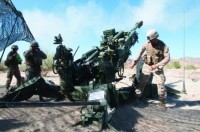I would love to say this is a post about ghost hunting, but that would be silly. Ghosts aren’t always invisible.
– JLT

An AN/PDR-77, a device used to detect and measure radiation, sits outside a simulated disaster site during a 2nd Marine Logistics Group training exercise aboard Camp Lejeune, N.C. (Photo by Lance Cpl. Devin Nichols)
Deadly radiation kills if it goes undetected, so it falls upon specially trained Marine to alert units of the unseen danger.
More than 30 Marines from various units within the 2nd Marine Logistics Group learned how to counter radiation by using the AN/PDR-77 during the Monitor Survey Reconnaissance Course.
“Every unit is responsible for having a select number of Marines who are certified with this equipment,” said Sgt. Steven D. Potts, a chemical, biological, radiological and nuclear defense specialist with Combat Logistics Regiment 27, 2nd MLG.
It could possibly save the lives of many service members, he added.
CBRN defense specialists trained the Marines to use the AN/PDR-77, a small, box-shaped sensor that detects alpha, beta, gamma and X-ray radiation.






Recent Comments